Planning a visit to the artsy elegant city of Parma Italy? This is the ultimate one day in Parma itinerary to help you optimize your time.
Why should you travel to Parma? Three reasons. It’s one of Italy’s most beautiful towns, a foodie haven, and home to the greatest works of the famed Renaissance artist Correggio.
Parma has a gorgeous Romanesque cathedral and pretty pink octagonal Baptistery. The entire town is dotted with red, pink, and yellow walls. Purple flowers decorate the Ponte Verdi.
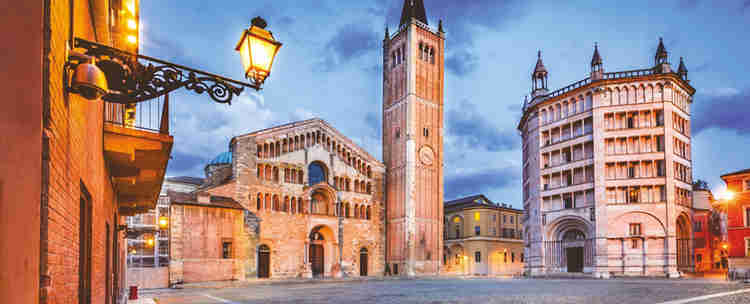
Parma is tailor made for art lovers. The town was home to Correggio, the opera composer Giuseppe Verdi, and the conductor Toscanini. In 2022, Parma was chosen as Italy’s Capital of Culture.
Precious frescos by Correggio literally blanket the city. There are art-filled palaces, a famous opera house, and a world class museum.
Parma will also appeal to traveling foodies. It’s home to some of Italy’s best known culinary products — parmesan cheese, prosciutto, fresh pasta, and other delicacies. All this goodness has led the town to be dubbed the heart of the “Italian Food Valley.”
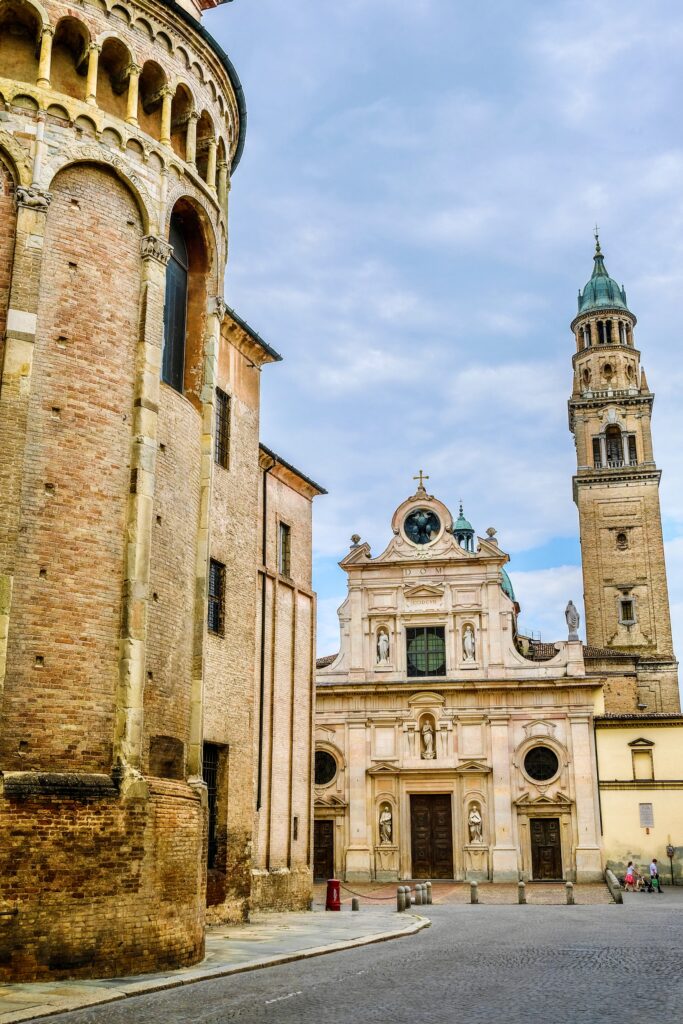
Snapshot Of One Day in Parma Itinerary
At a quick glance, your one day in Parma will look like this:
- Parma Cathedral
- Correggio Dome
- Parma Baptistery
- Sanctuary of Sante Maria della Steccata
- Camera di San Paolo
- Piazza Garibaldi
- National Gallery of Parma
- Teatro Farnese
- Church of San Giovanni Evangelista
- Parma Food Tour
- Teatro Regio
You can add or subtract things based on your own interests and pace of travel.
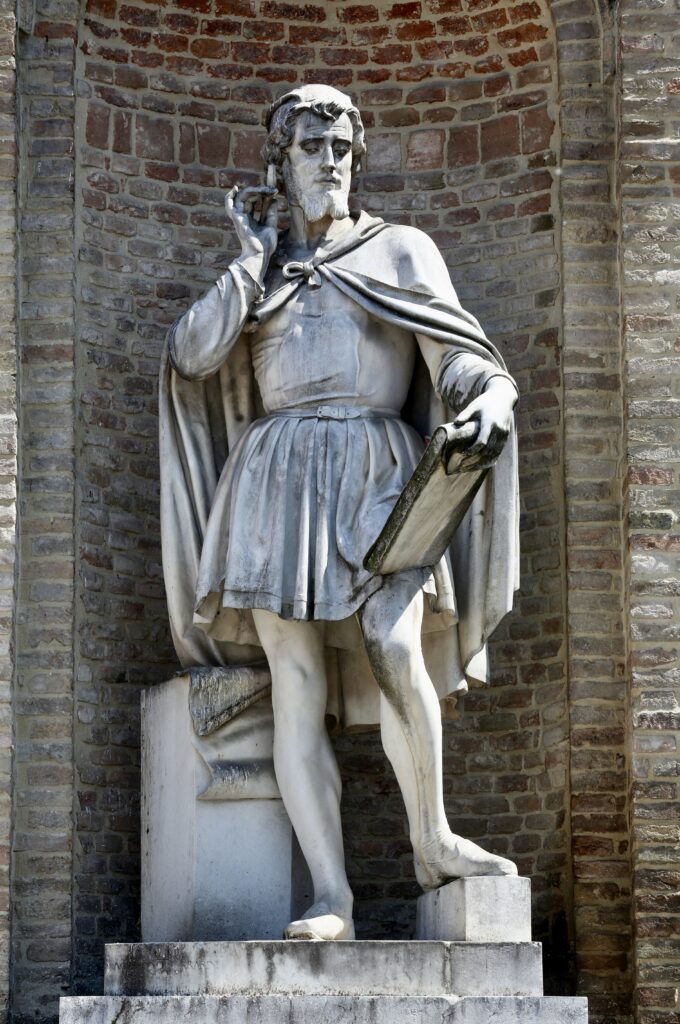
Who Was Correggio?
Parma is synonymous with the Renaissance master Antonio Correggio, the town’s native son.
Correggio was a late Italian Renaissance painter. He was known for his erotic mythological paintings and was a master of chiaroscuro (dark-light contrasts). His work is considered porto-Baroque, anticipating the more animated Baroque period to come.
Haven’t heard of him? Well, Correggio isn’t as well known as his contemporaries Michelangelo or Raphael, for sure.
That’s because he was based in Parma, an obscure town compared to Rome or Florence. It’s not exactly on your standard touristic itinerary when visiting Italy.
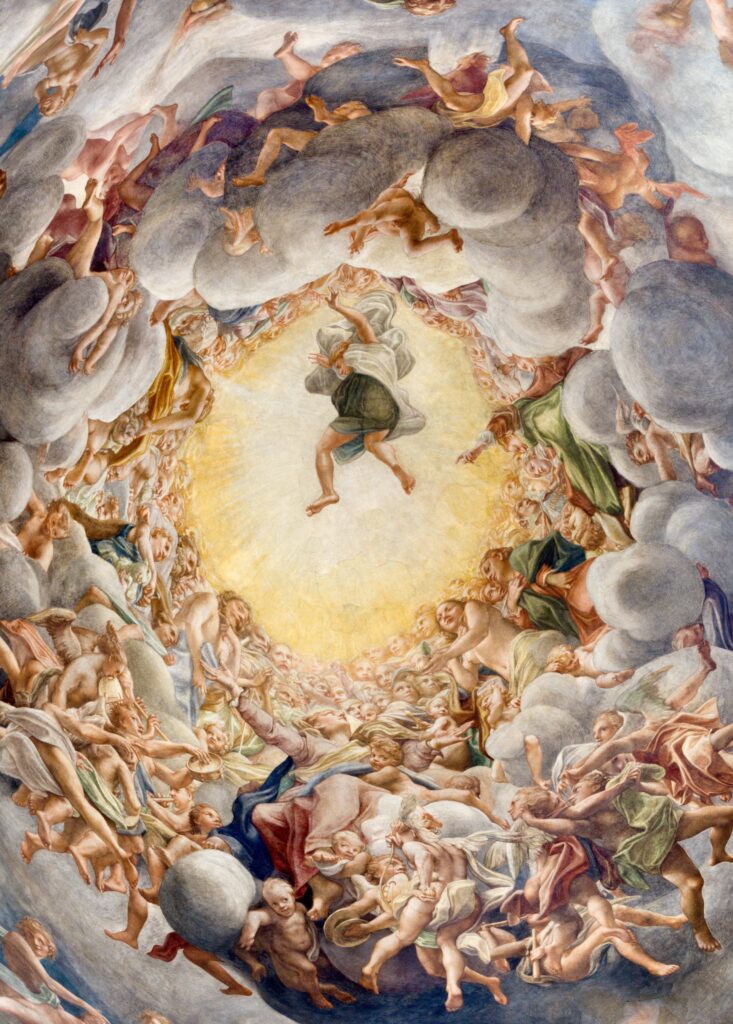
Art historian Giorgio Vasari says Correggio never even traveled to Rome. So, he’s a self made genius.
Biographical information about Correggio is scarce.
The artist is a mysterious figure, with an undocumented life. We do know he moved to Parma in 1519 and lived there until his sudden death in 1534.
Correggio was reputedly both impoverished and aristocratic, uneducated and well-trained. Whatever the truth, historians consistently praise him for his naturalism and ability to capture feminine beauty.
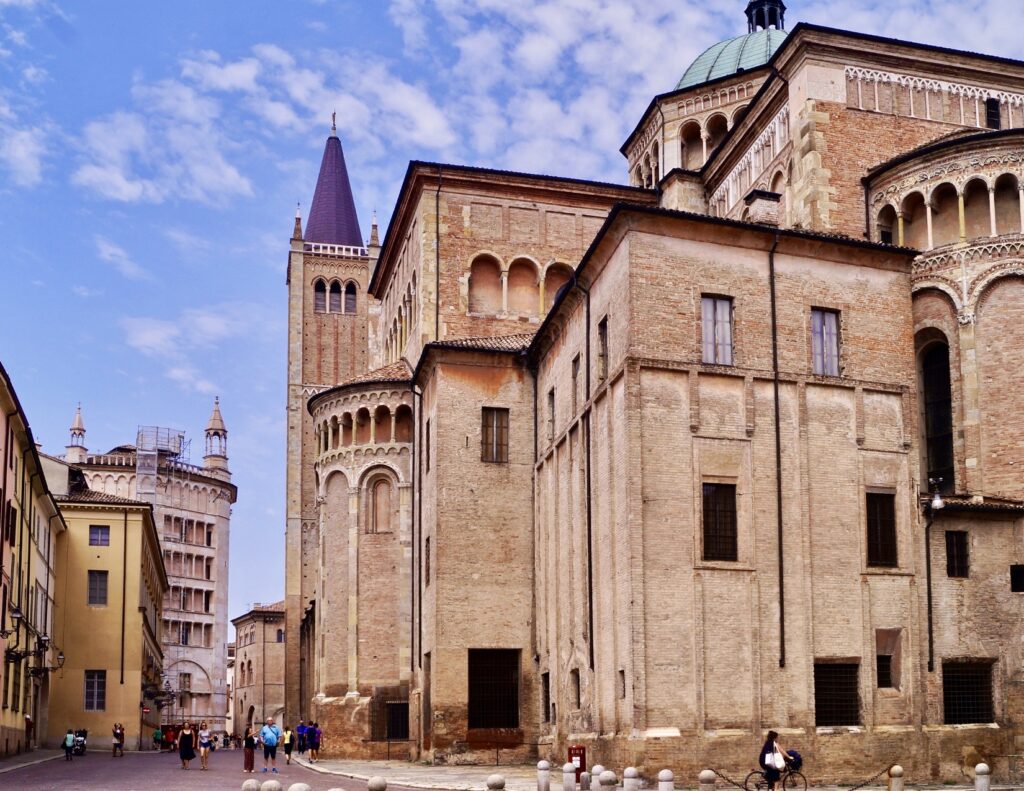
One Day In Parma Itinerary
You might consider kicking off your visit with a guided walking tour, to get the full scoop.
Morning
Parma Cathedral
Start your one day in Parma itinerary at Parma Cathedral, which is free to visit. Officially knowns as Santa Maria Assunta Cathedral, it’s one of the most beautiful churches in Italy.
First built in 1074, the ancient church lies in the Duomo Square and opens at 7:30 am. Two 13th century lions guard the main entrance.
The cathedral is dedicated to the Virgin Mary and is considered one of the finest examples of Romanesque architecture in Italy.
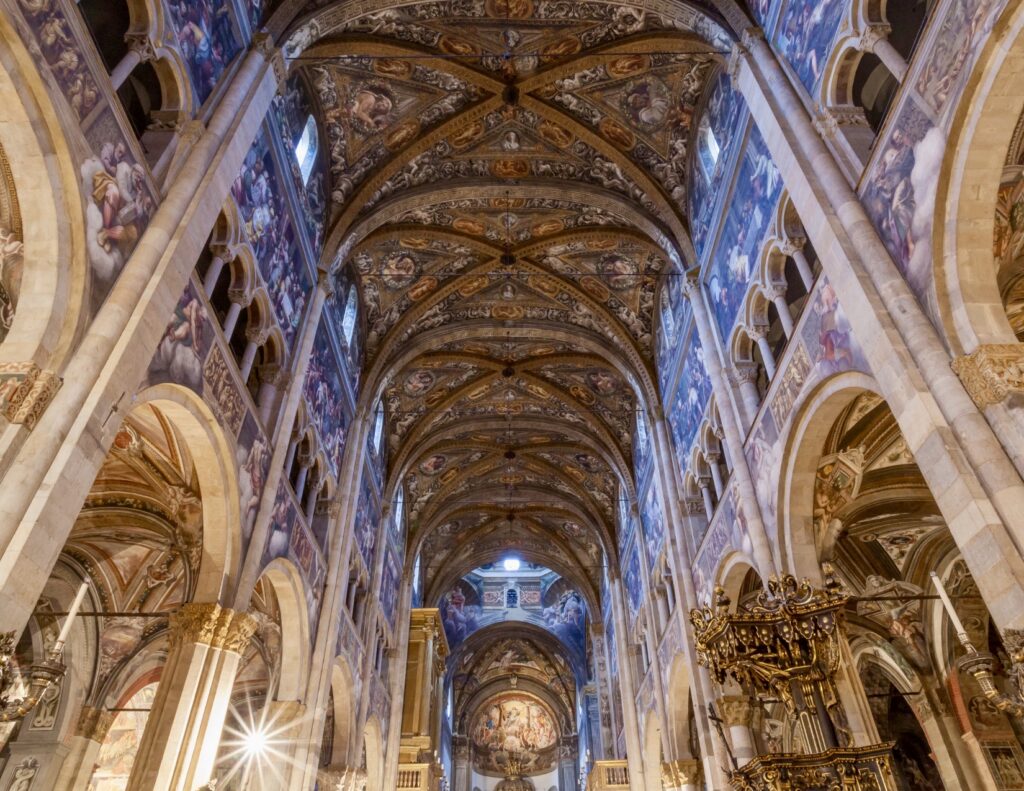
The cathedral was originally erected by the heretic bishop Cadalus. It was destroyed by an earthquake in 1117, and rebuilt in the 12th century. The striking 13th century bell tower is topped by a gilded copper angel.
The rather demure facade features three loggia floors and three portals. The doors were sculpted by Luchino Bianchino in 1494.
Inside, the medieval interior has a Latin cross plan filled with elegantly curved arches. The long nave is covered in frescoes depicting stories from Christ’s life.
A 16th century red marble staircase leads up to the transept. There, you’ll find the famous Deposition by architect and sculptor Benedetto Antelami. The stone relief sculpture is a masterpiece of Gothic art, dating from 1178.
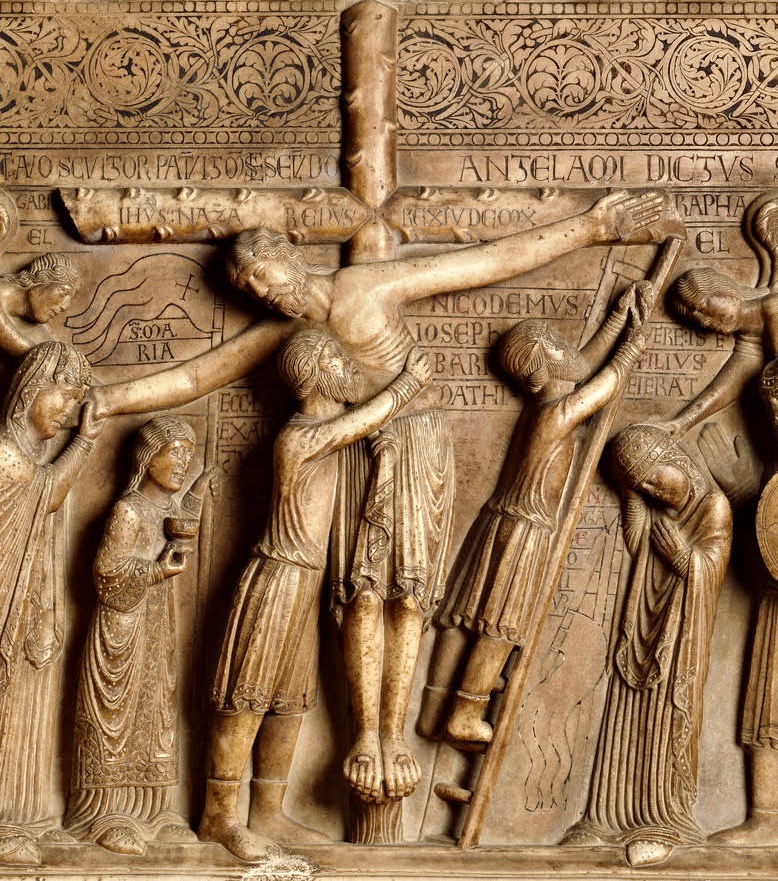
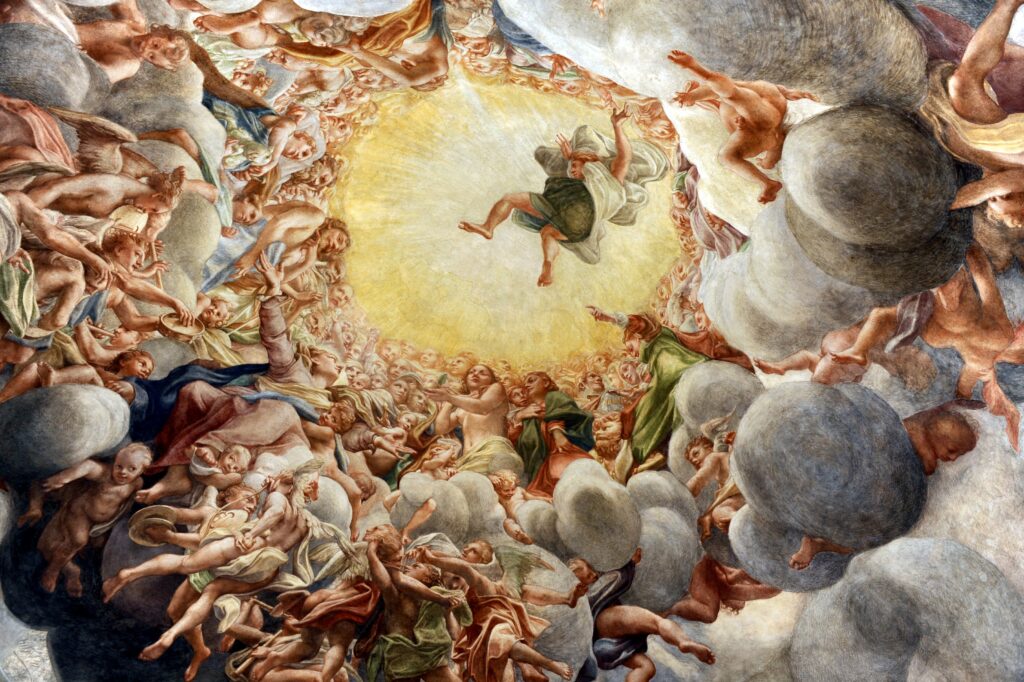
Dome Of Parma Cathedral
The stunning Correggio fresco in the cathedral’s cupola dates from 1526. It’s one of the most famous paintings in history and transformed the art of dome interiors.
The artist spent 8 years creating this mesmerizing High Renaissance masterpiece. It’s an absolute must visit with one day in Parma. The fresco’s theatricality foreshadows the coming of the Baroque period. You’ll need to pay a few euros to light it up.
The fresco depicts The Assumption of the Virgin, i.e., the moment she is passively assumed into heaven and joyfully reunited with her son. Craning her head upward, Mary rises through an ocean filled with frolicking angels and dense clouds. Adam and Eve are on Mary’s right and left.
The angels seem inspired by Michelangelo’s nudes from the Sistine Chapel frescos. Though they are softer. The fresco’s illusionistic quality was possibly inspired by Andrea Mantagna’s Camera degli Sposi in Mantua.
In the center of the fresco is a circle of divine light. A leggy and beardless figure tumbles down to meet Mary. He most likely is Jesus, but he may also be an angel. It’s not God, as you would typically see in an assumption.
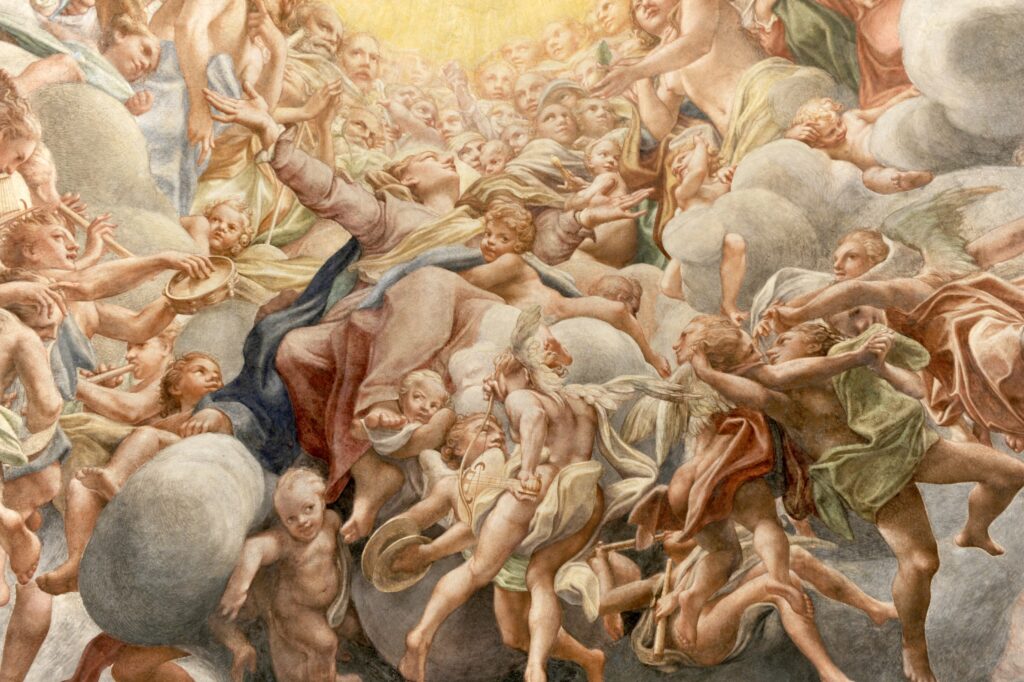
Using radical and illusionistic foreshortening techniques, Correggio’s figures in the clouds protrude in a wild delirium. It’s a lot to take in, almost dizzying.
In the pendentives below, you can see the four saints of Parma. Correggio painted these figures as well.
For a closer look at the frescos, you can walk up the stairs on the right side of the nave.
At first, the canon of the church didn’t appreciate the sheer dramatic energy of Correggio’s work. They’d never seen anything that looked like this.
They approached the Venetian artist Titian to ask if he would repaint the dome. Titian refused, saying Correggio’s work was truly “masterful.”
Instead, he suggested the church authorities turn the dome upside down, fill it with gold, and hand it over to Correggio.
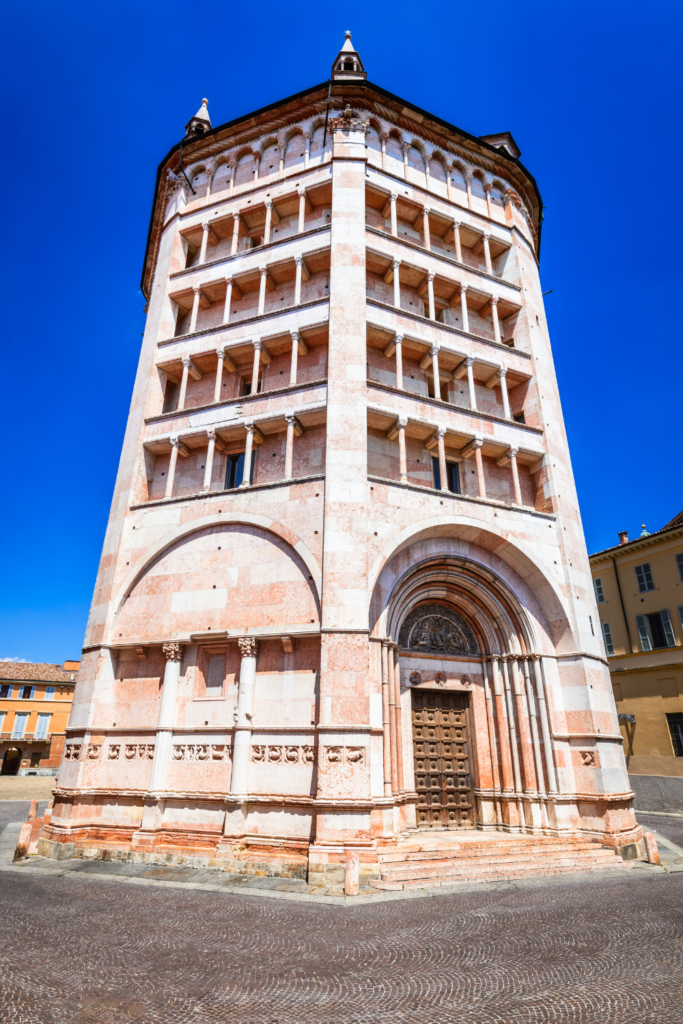
Baptistery of Parma
The baptistery is right next to the cathedral. It was the brain child of the great Romanesque architect Antelami and is perhaps the most singular and spectacular baptistery in Italy.
Begun in 1196, it’s a mix of Romanesque and Gothic styles. The baptistery has a unique octagonal shape. On each side are four open loggias with 16 slender columns.
The building was constructed by alternating white and pink Verona marble, colors which represent purity and the blood of Christ.
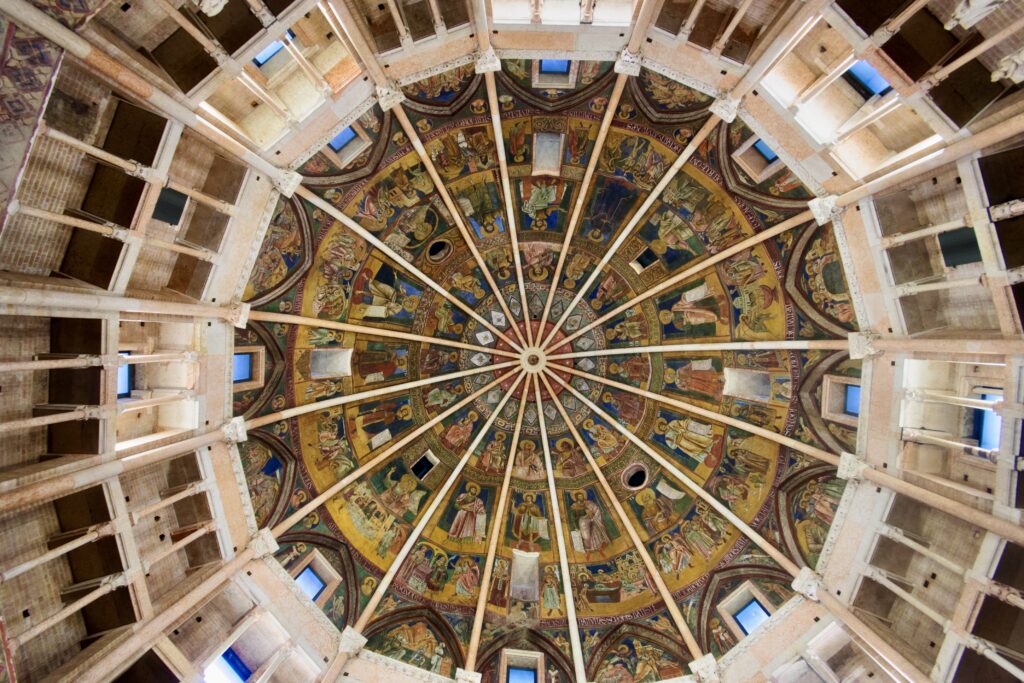
Inside, you’ll find colorful 13th century ceiling frescos depicting the seasons and the zodiac signs. They were painted by craftsman from the Po River region.
The ceiling is an umbrella vault divided into 16 sections, extending from the central keystone. The frescos are Byzantine in style.
In the center of the Baptistery is an octagonal baptismal font intended for full immersions. A smaller second font is in a niche.
Of the many statues in the baptistery, the two most famous are sculptures of two seasons (winter and spring)by Antelami.
It costs € 12,00 to visit both the Baptistery and the Diocesan Museum. I didn’t have time to go in the museum myself. But it displays statues by Antelami, early Christian artifacts, coins, Roman stuccoes, and early Medieval ceramics.
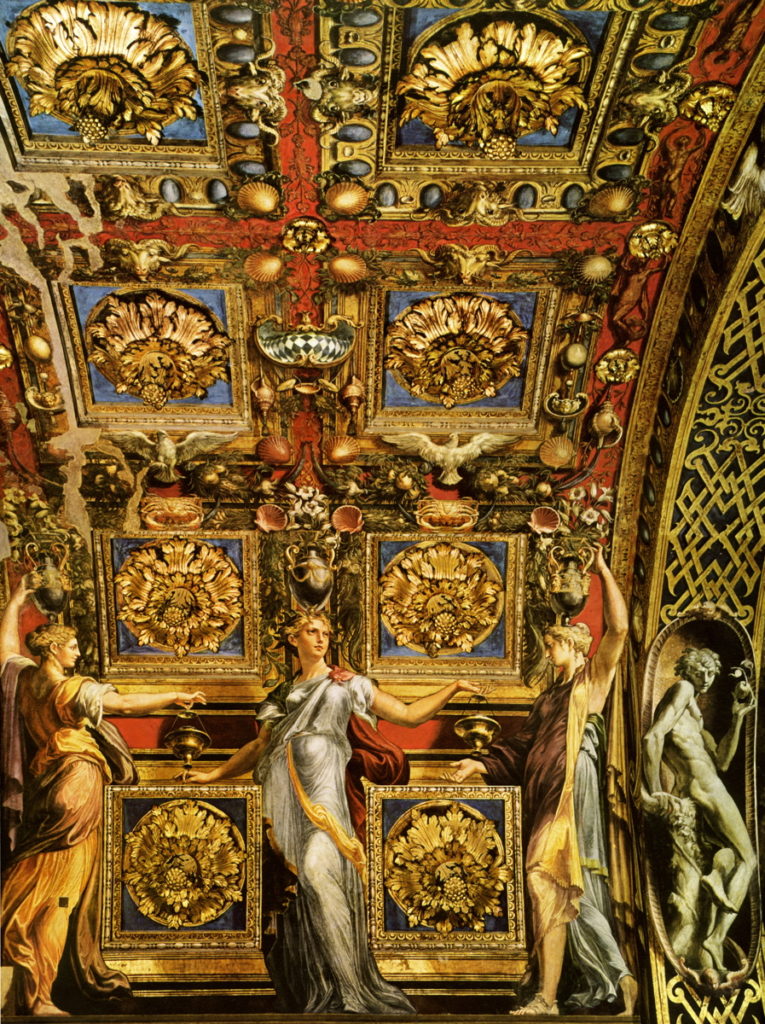
Sanctuary of Sante Maria della Steccata
Next up is the Sanctuary of Sant Maria della Staccato.
Built beginning in 1591, it’s a beautiful Renaissance church not far from the cathedral. It’s a shrine dedicated to a fresco depicting the Virgin Mary breastfeeding Christ.
The church was inspired by the designs of the famous Roman architect Bramante. It has a Greek cross plan ending in semi-circular apses. There are many chapels.
But the thing to see, above the great altar, is a spectacular fresco. It’s a masterpiece created by Parmigianino, the great Mannerist painter, in 1530-39. It depicts the parable of the wise and foolish virgins. It’s worth visiting the church just to see this fresco cycle alone.
You’ll also find tombs of the dukes of the houses of Farnese and Bourbon.
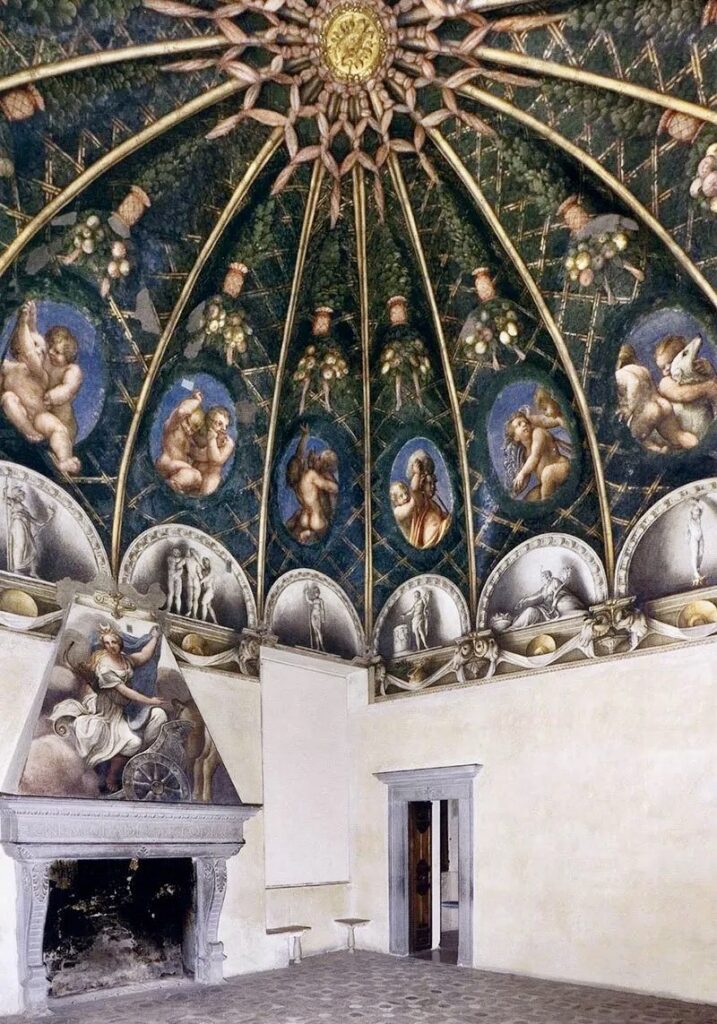
Camera di San Paolo
Just 5 minutes from the Baptistery is the Camera di San Paolo. It was Correggio’s first major commission. It proved to be a warm up for his more fantastical dome frescos.
The Camera (or room) was the private space of Giovanna Piacenza, a worldly abbess of a Benedictine nunnery. The room wasn’t open to the public.
The abbess likely used the room to entertain or dine with guests. In the center of the dome, you can even see her coat of arms.
Painted in 1519, the illusionistic ceiling fresco exploded the career of Correggio. The fresco is like a pergola divided into 16 sections. This is similar to the fresco decoration in the Baptistery.
The fresco rests on faux marble lunettes along the walls. The subjects are mythological. But it’s unclear what each individual scene means or how they connect to the meaning of the room.
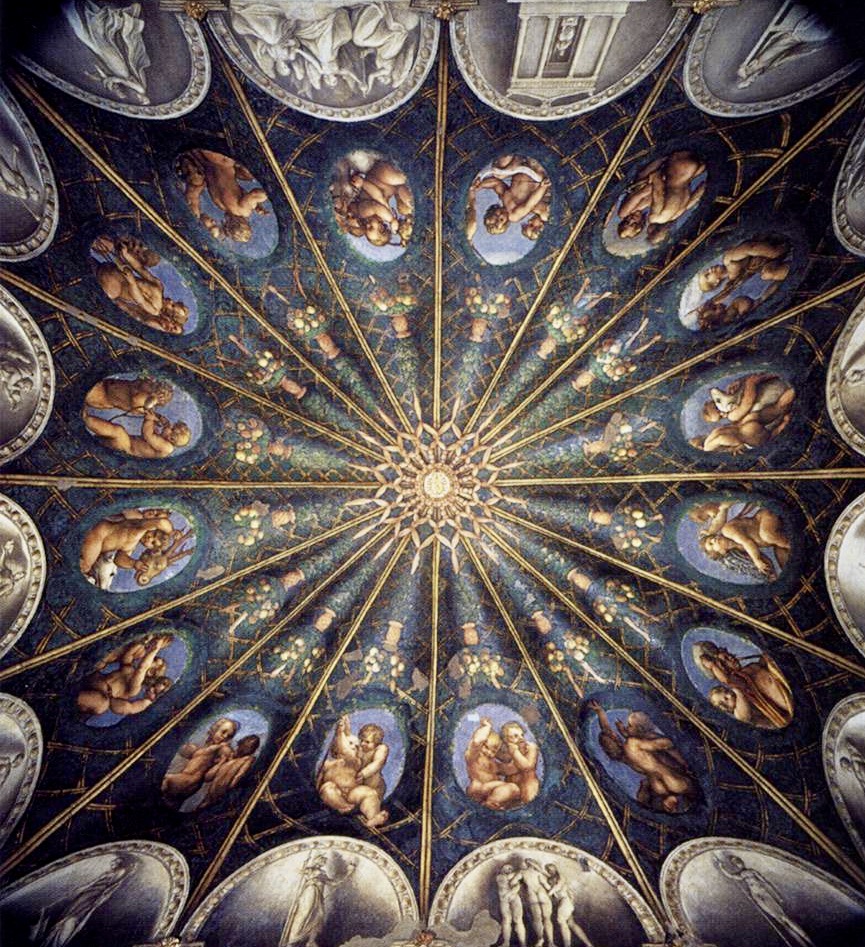
The fresco is filled with mythological and festive motifs. In the oval apertures are little putti. They hold objects associated with hunting.
Above the fireplace is a fresco of the Diana, who was the goddess of hunting and chastity. There’s also an inscription that reads “Do not stick your poker into the fire.” Perhaps that was a reminder that, in the midst of all this cultured classical imagery, you were still in a nunnery.
The Camera stands as one of the great works of the High Renaissance. Ceiling frescos were very rare at the time.
It proved a turning point in Correggio’s career. Yet no one could have seen his work. No one but the monks in the Benedictine monastery, who likely spread the word.
Afternoon
Lunch
For lunch, grab a sandwich at Bread. The local favorite there is the pork-filled Spaccaballe Roast. Or, you can try a cozy trattoria like Osteria Dello Zingaro or Osteria Del Gesso.
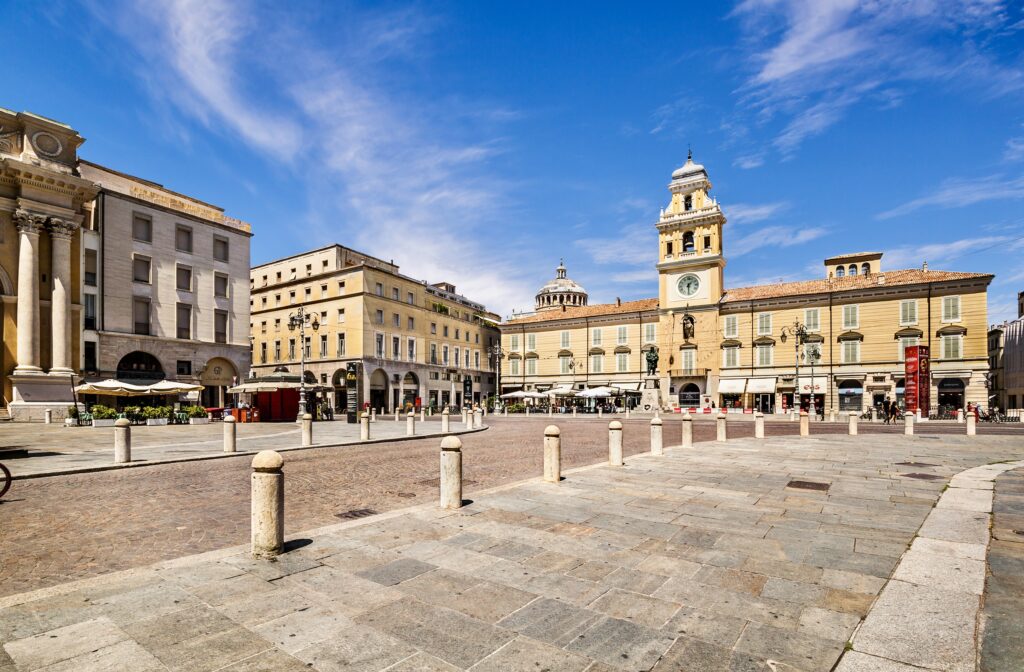
Piazza Garibaldi
After lunch, continue your one day in Parma with a leisurely stroll around Piazza Garibaldi and enjoy the Parma street life. Parma has a number of charming squares, but Piazza Garibaldi is the most notable.
In the center is a statue of Guiseppe Garibaldi, who was instrumental in unifying Italy. There are loads of shops, eateries, and outdoor cafes.
The Palazzo del Governatore, a Baroque and Neo-Classical building, dominates the square. Inside is the Museum of Modern and Contemporary Art.
Be sure to wander down the hidden side streets. Every street features beautiful houses in different colors. Via Ferdinando Maestri is picturesquely strung with lamps and lanterns.
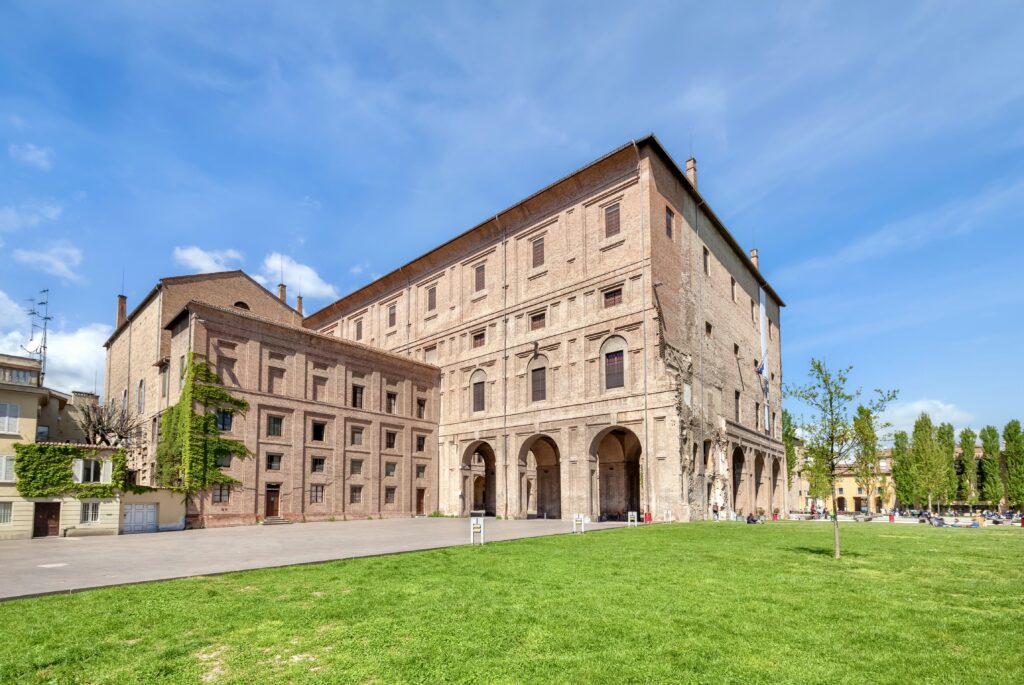
National Gallery Of Parma
Do you love old masters? You’ll be thrilled by the National Gallery. It’s a superb museum with a world class collection of Medieval and Renaissance paintings.
The museum is housed in the Palazzo della Pilotta, the former home of the Farnese family. The family was so illustrious they produced popes, dukes, and cardinals.
The Farnese family lived there until the final heir decamped to Madrid to marry the Spanish king. In her absence, the Hapsburg princess Marie-Louise was awarded the duchy.
She got busy collecting art works that were left in abandoned Farnese palaces and from other villas and churches in Italy.
You’ll find a rare Leonardo da Vinci and paintings by Parmagiano, Canaletto, and more Correggio. There are also work by Northern European artists like Hans Holbein, Van Dyck, and Breughel.
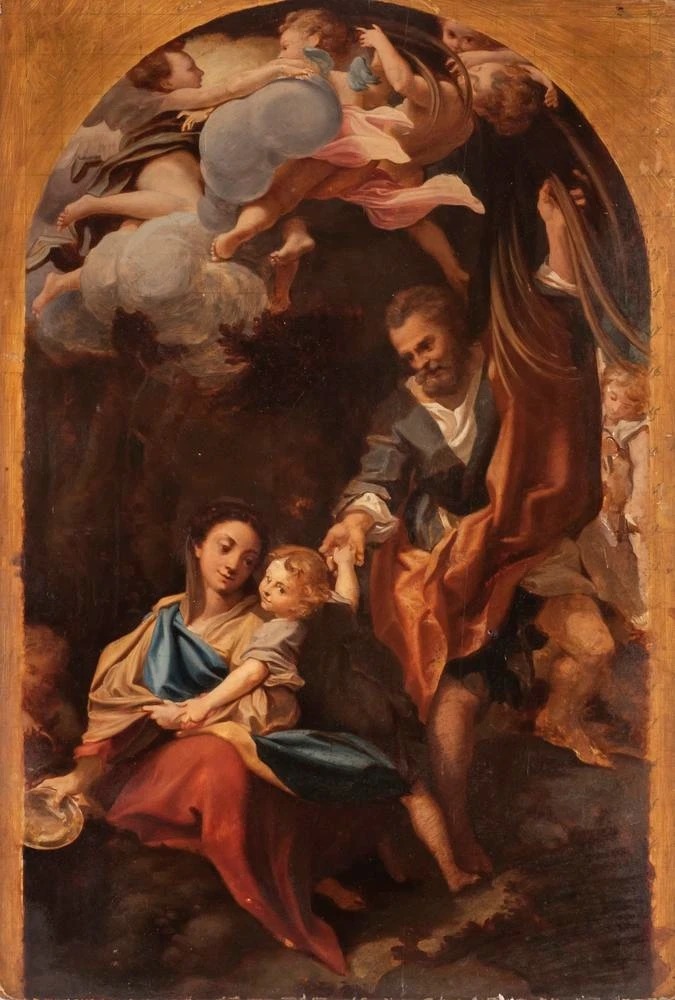
There’s an extraordinary collection of Correggio paintings displayed in multiple rooms, which are the most important pieces in the museum.
Madonna della Scodella is a painting commissioned around 1524 for the Sepulcro Church in Parma. It’s considered Correggio’s greatest altarpiece and is still in its original frame.
The biblical subject of the work is the rest on the return from Egypt. Christ sits on Mary’s lap looking out over his left shoulder and Mary looks adoringly at her son.
Correggio’s The Lamentation was also commissioned in 1524. The moving image shows the moment when Christ is being lamented. In biblical sequence, the lamentation follows the pieta, where Mary holds Christ in her arms.
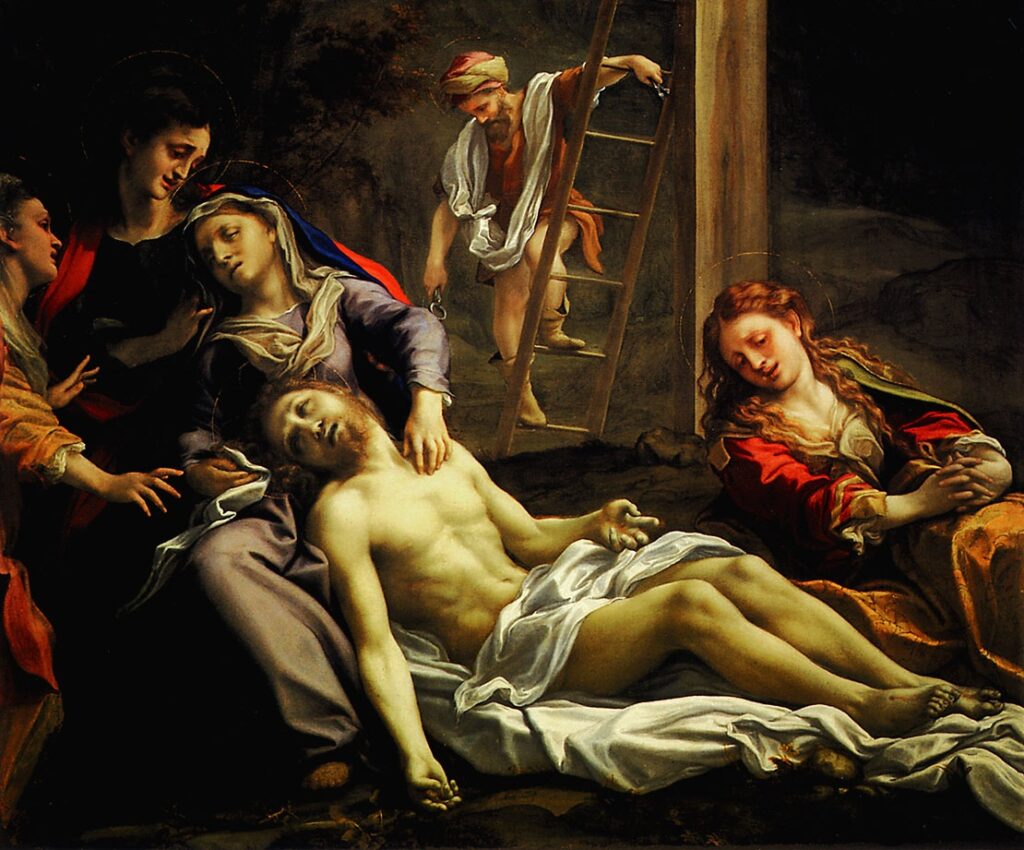
At Christ’s feet is Mary Magdalene, recognizable by her beautiful long strawberry blond hair. In the background, you can see the male figure of Nicodemes descending a ladder that he used to remove Christ’s body from the cross.
The overall impression is powerful. The expressions on their faces invoke feelings. Correggio is not depicting real life, but creating it with shimmering rhetorical flourishes.
Lamentation’s rather grisly companion piece is the Martyrdom of Four Saints. To the far right hand side, you can see part of a hovering disembodied head. In the lower part of the painting is a severed head. The executioner is about to deliver the final blow.
It’s an unnerving painting with a sense of exaggerated movement. The violence is depicted with elegance. The painting is beautiful but horrific at the same time.
La Scapigliata is the museum’s most famous art work and one of Leonardo’s most celebrated pieces.
Executed during Leonardo’s mature period, the tiny unfinished portrait remains largely a mystery. It’s halfway between preparatory drawing and formal panel painting.
La Scapigliata is classic Leonardo in style. It’s full of soft lines and gentle shading. The painting is subtle — full of nuanced emotion, rather unfathomable, and meditative.
Leonardo wasn’t just depicting a disheveled woman, but rather showing her natural beauty, sweet features, and curious inner light.
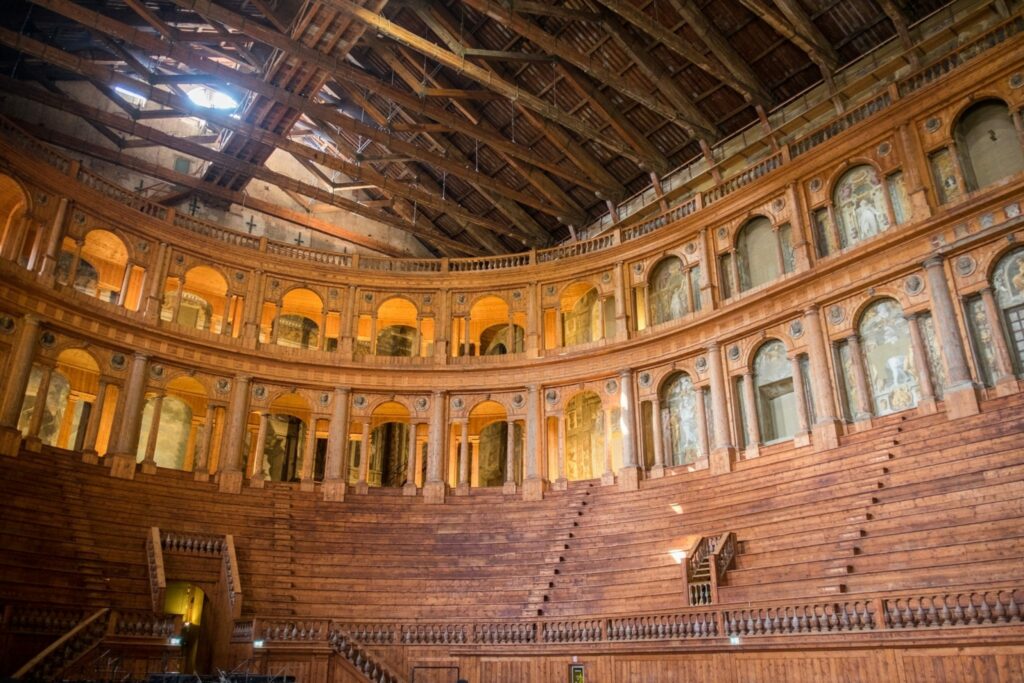
Teatro Farnese
The Teatro Farnese is also in the Palazzo Pilotta. It’s actually the entry point for the museum.
It’s a Baroque style wooden theater built by the Farnese, similar to the Palladian Theater in Vicenza. They built the theater to impress Cosimo II of Florence’s Medici family on his visit in 1619.
The theater was inaugurated in 1639, but has only been used a few times since. It was used more as a venue for noble weddings and court visits. There is seating or 3,000 people.
The theater was almost entirely destroyed in 1944 during an Allied raid in World War II. But it was painstakingly reconstructed and reopened in 1962.
You can only visit the theater if you purchase a combination ticket for 12 euros. That also gives you entry to the National Gallery, Palatine Library and the Archaeological Museum. It’s well worth it because the theater is spectacular in person.
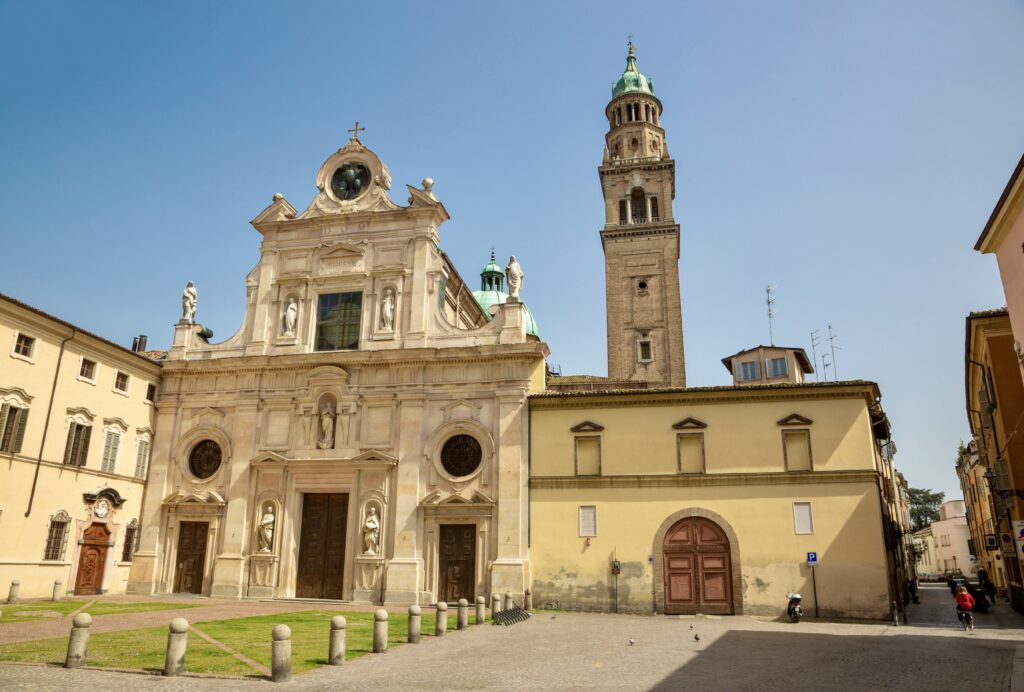
Church of San Giovanni Evangelista
This church was built for the Benedectine order between 1498 and 1519 after a fire destroyed the previous church. It’s located directly behind Parma Cathedral.
The doors will be closed, but they’re not locked. So don’t be deterred. Just push your way in.
There’s also an illumination box that you put euros in to light up the paintings. You can select up to four areas.
In 1604, an elaborate pink marble Baroque facade was added, which contrasts with the Renaissance architecture of the adjoining cloisters and convent.
Inside, there’s a Latin cross plan and (yes!) even more beautiful paintings by Correggio. He painted the frieze running along the nave, a lunette above the sacristy door, the grotesque frescos in the nave columns, the entrance to a chapel, and the famous fresco cycle in the dome.
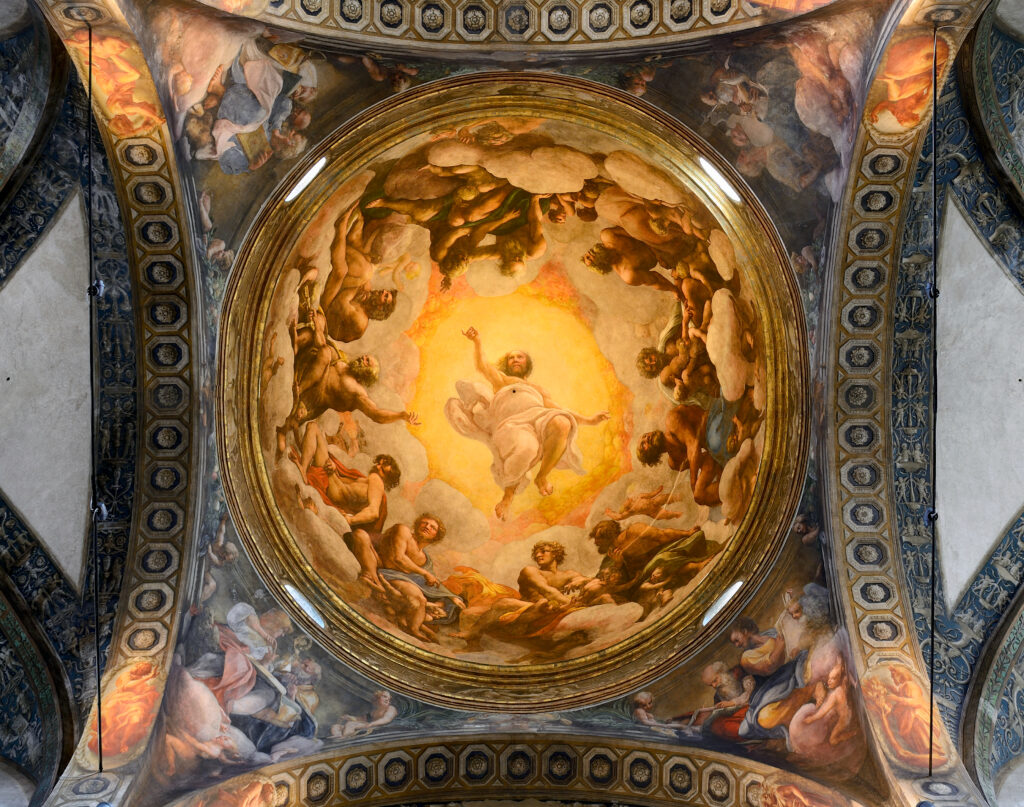
By far, the most spectacular piece is the dome fresco depicting Jesus and the apostles.
This is the first of Correggio’s illusionistic dome frescos. It’s created in a dramatic di sotto in su perspective, which makes it seem like the figures are standing on a transparent piece of glass.
The subject of the fresco is somewhat unclear. It may be the death of St. John the Evangelist. Others say it’s the vision of St. John on the Greek island of Patmos that comes from his book Revelations.
A bearded Christ is in the center. Behind him is a glowing ball of light representing heaven.
Around him 11 apostles sit on clouds, actively engaged in conversation. Some art historians think Correggio was the inventor of the “clouds as architecture” device.
In the four pendentives (upside down triangles) at the corners of the dome, there are pairs of saints and evangelists.
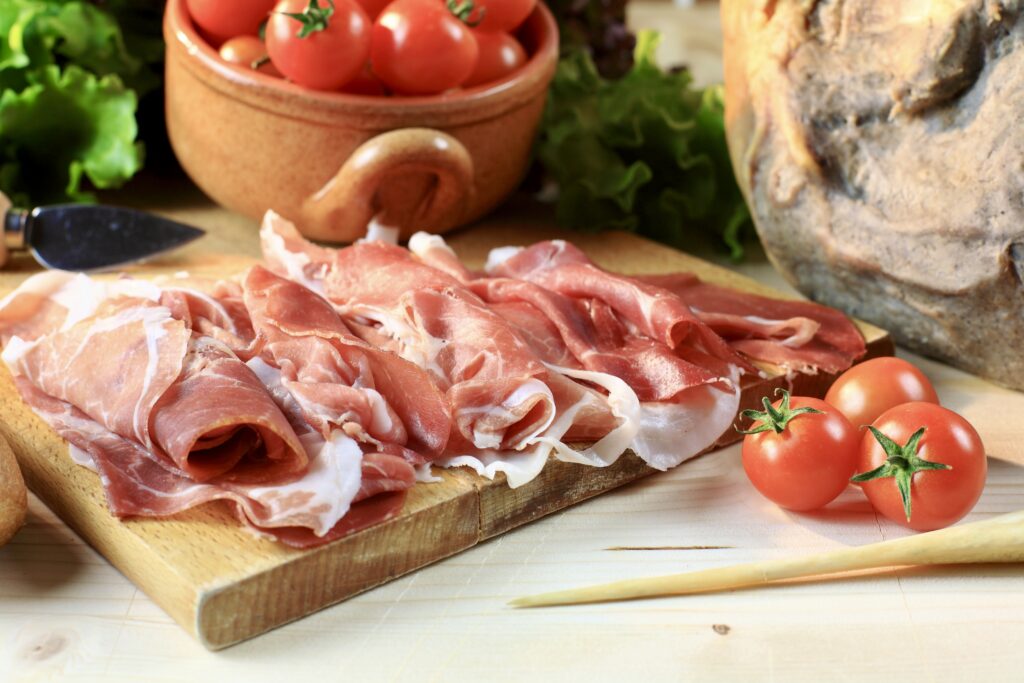
Parma Food Tours
Parma is a UNESCO City for Gastronomy. When you’re in one of Italy’s foodie towns, you should definitely take advantage and go on a food or factory tour to properly experience the famous treats.
Parma is famous for its namesake prosciutto di Parma (Parma ham) and parmesan cheese. The town is also known for its fancier and more expensive prosciutto, culatello, and its Lambrusco wine. It’s also home to the famous pasta making factory, Barilla.
Check out these cool food tours in Parma:
- 5 hour prosciutto and parmesan tour
- 7 hour cheese, ham, and balsamic tour
- 3.5 hour traditional food tour
- 2 hour tour of parmesan cheese factory
- 2 hour tour of dairy and prosciutto factory
You can also purchase these goodies at shops all over town. No belly will go empty!
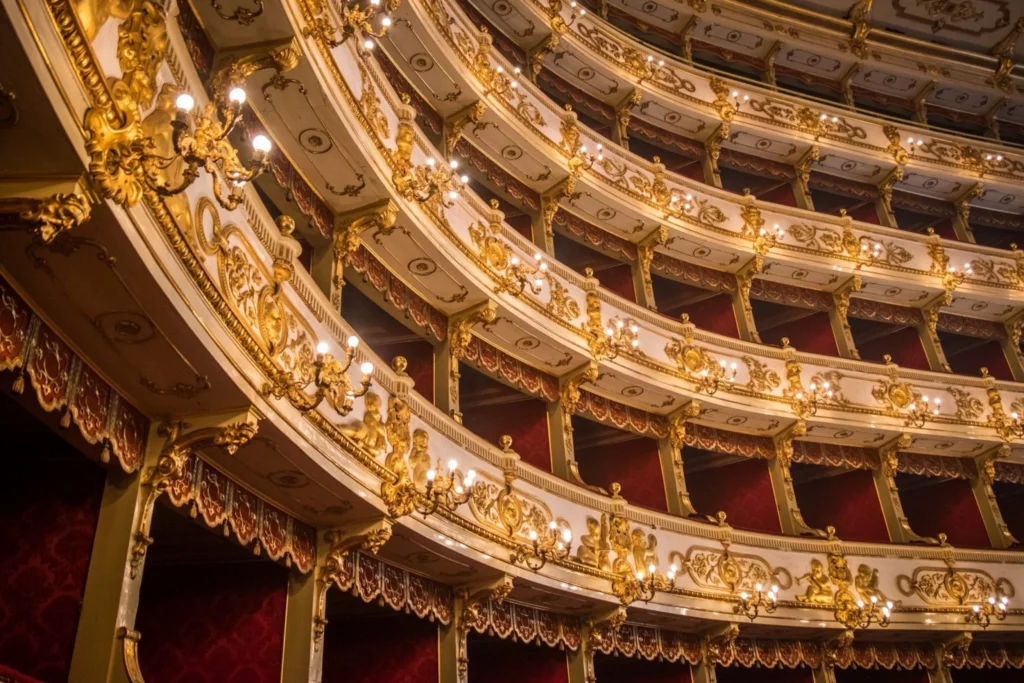
Evening | Teatro Regio
In the evening, have an aperitivo at Tcafe, which overlooks the octagonal medieval baptistery. Grab dinner at Borgo 20, F.I.S.H., or Restaurant La Forchetta.
You might also take in a performance at Parma’s beautiful 19th century opera house, Teatro Regio. It’s an over the top Neo-Baroque extravaganza with an opera season that rivals Milan’s. It has a capacity of 1,400 with 5 tiers of seats decorated with red velvet and gold trim.
Even if you don’t care for opera, the theater offers 30 minute tours of both main theater and backstage.
Naturally, Parma is pretty Verdi-crazy and Verdi operas are frequently performed. The town also puts on a Festival Verdi each year in October.
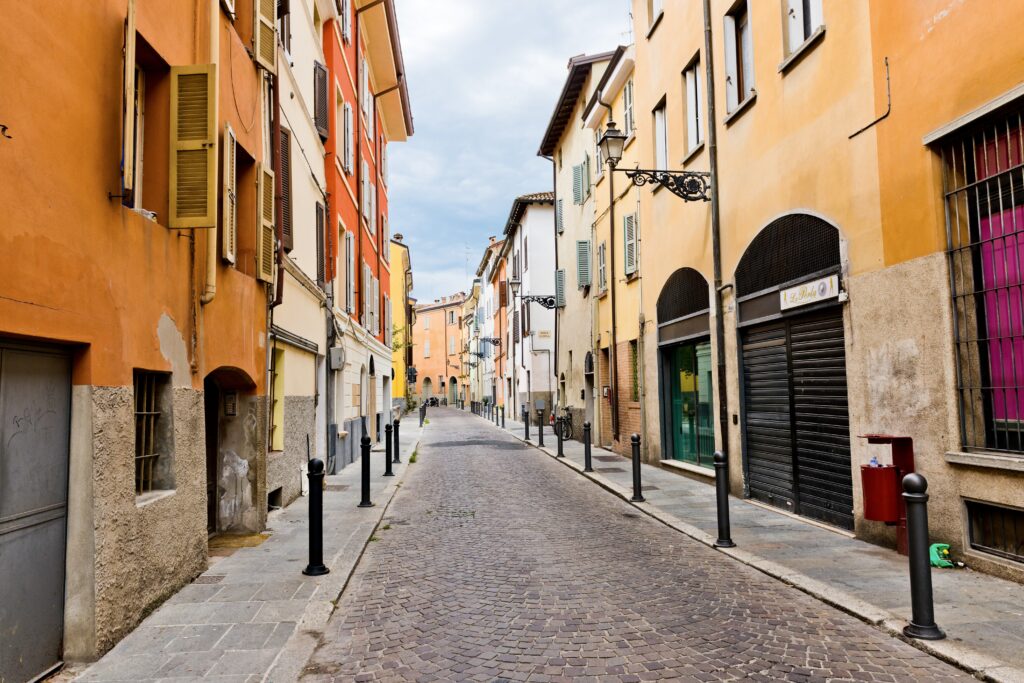
Tips For Visiting In Parma
1. How To Get To Parma
Parma is a compact riverside city located in the Emilia Romagna region of northern Italy, between Bologna and Milan. Parma is easily accessible from Bologna airport (1 hour) and Milan airport (1:45) via rental car.
Driving in the historic center of Parma is prohibited. You can park just outside on a street with blue lines and pay for a ticket at the curbside parking kiosk.
If you’re taking the train to Parma, the city is strategically located on the train line between Milan and Bologna.
From Milan, it’s a 47 minute ride on the high speed train. From Bologna, it’s approximately 40 minutes. The Parma train station is just a short 10-15 minute walk to the old town.
You can also visit Parma on a guided day trip from Milan or on a guided tour from Florence.
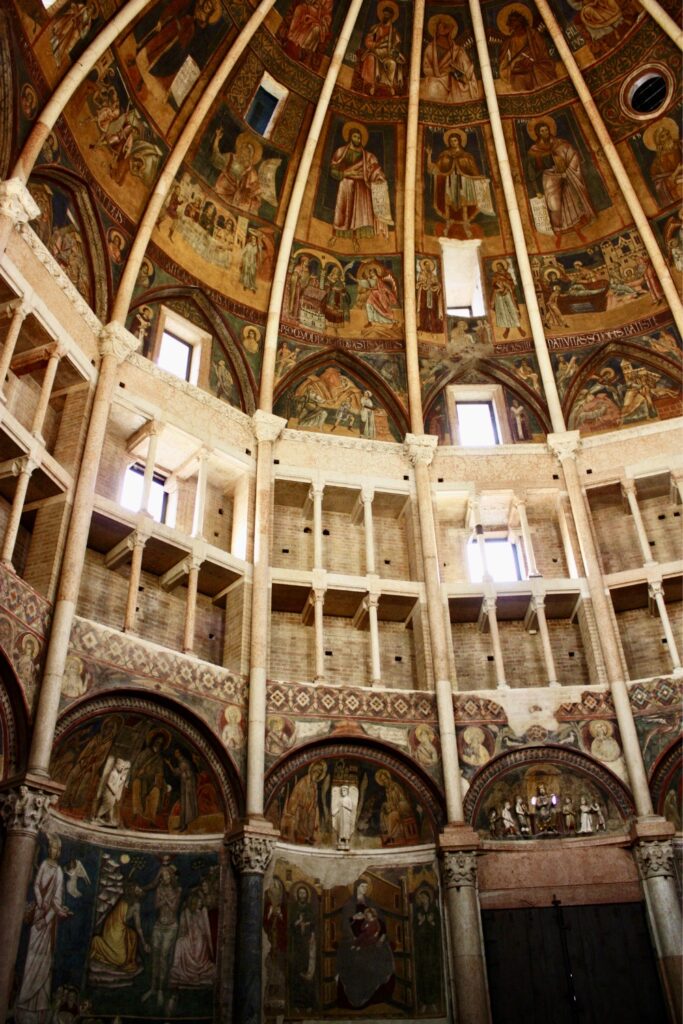
2. How To Get Around Parma
Parma is a very walkable city of 200,000 people. The best things to do in Parma are clustered around the Piazza del Duomo and the Palazzo della Pilotta.
The sites are just a stone’s throw from each other. This makes Parma a very feasible day trip.
You can also rent bikes from a stand outside the train station to get around. Or, go on a guided tour that combines biking and cheese tasting. You can also see the top Parma attractions on a guided rickshaw tour.
3. Where To Stay In Parma
If you’re not just day tripping to Parma, there are some nice nests to rest your head for the night.
The most luxurious hotel in Parma is Park Hotel Pacchiosi. It’s an elegant hotel in a historic building with rooms furnished in a Neo-Renaissance style.
Another 5 star hotel is the Grand Hotel de Ville. The hotel is housed in a converted pasta factory and decorated with items from the 1920s. A buffet breakfast is included and there’s a bar for an aperitivo.
Link 124 Hotel is a nice 4 star hotel with an excellent breakfast. The Hotel Sina Maria Luigia is another 4 star hotel with classic interiors and Italian style furnishings.
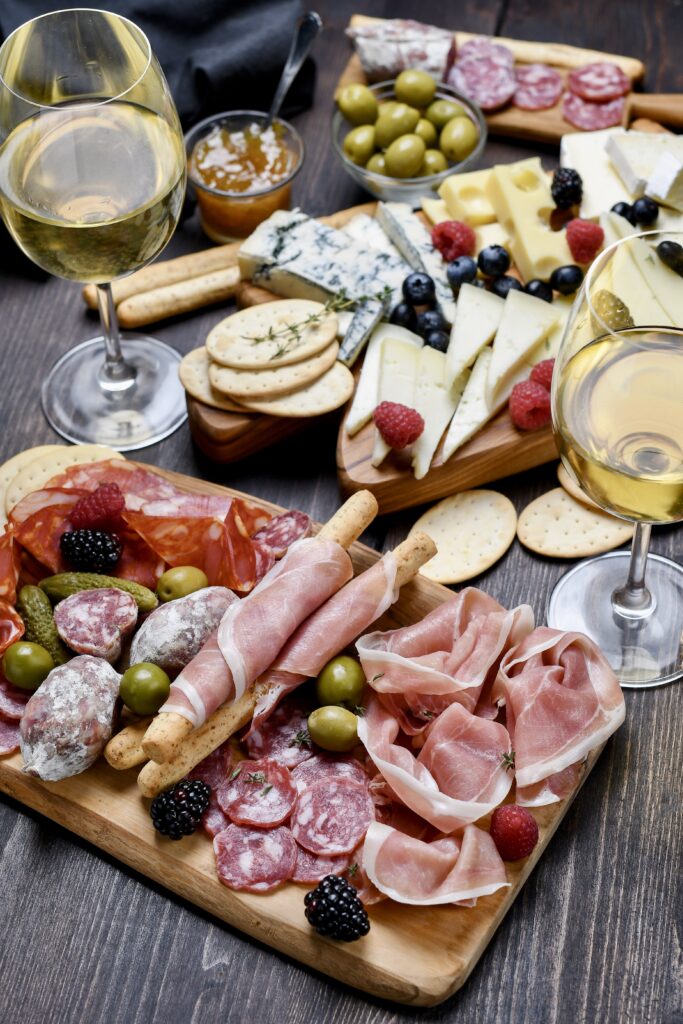
4. Is Parma Worth Visiting?
100% yes. Parma is a bit off the beaten path and you have to make an effort to get there to spend a day.
But if you love Renaissance art, the town is a must visit in Italy. Though lesser known, Correggio was one of the most important artists of the Reanissance and Parma is the place to see his works.
Likewise, if you’re a passionate foodie, a visit to Parma is in order. The town is the birthplace of Italy’s most iconic food and most delicious exports. You may experience sensory overload.
Plus, Parma is a town that’s easy on the eyes and a delight to wander. It’s akin to a big outdoor museum.
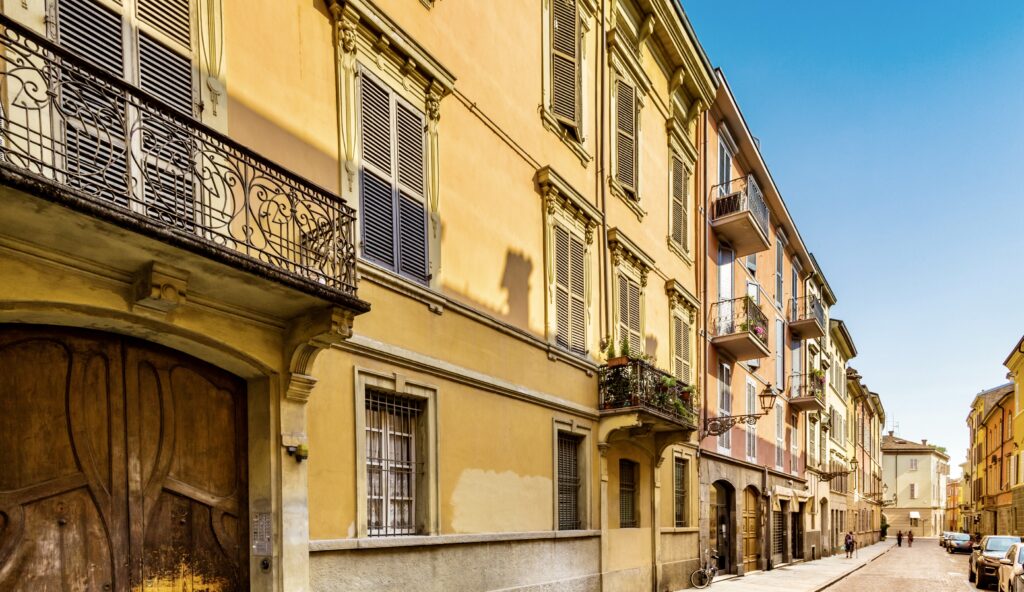
I hope you’ve enjoyed my one day in Parma itinerary. You may enjoy these other Italy travel guides and resources.
- Historic Landmarks in Italy
- Most Beautiful Towns in Italy
- 101+ Epic Experiences To Have in Italy
- 10 Day Itinerary for Italy
- 10 Day Itinerary for Tuscany
- 12 ways to spend 1 week in Italy
- 5 ways to spend 1 week in Sicily
- 10 day itinerary from Milan to Rome
- 3 Day Itinerary for Florence
- 2 Day Itinerary for Venice
- 24 Hours in Milan
- 24 Hours in Siena
Pin it for later.

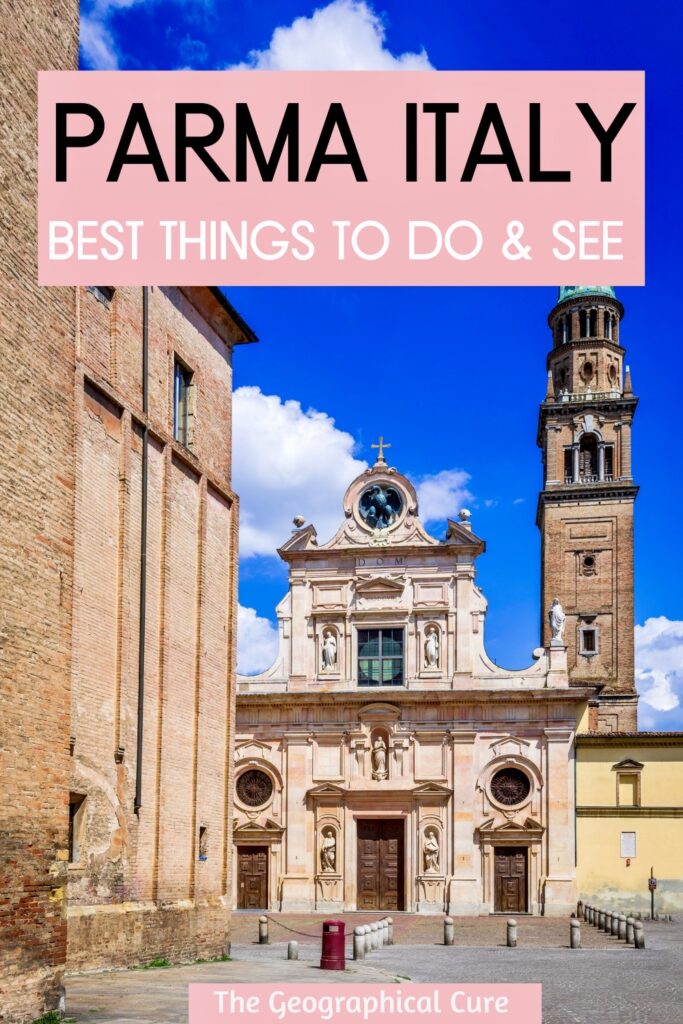
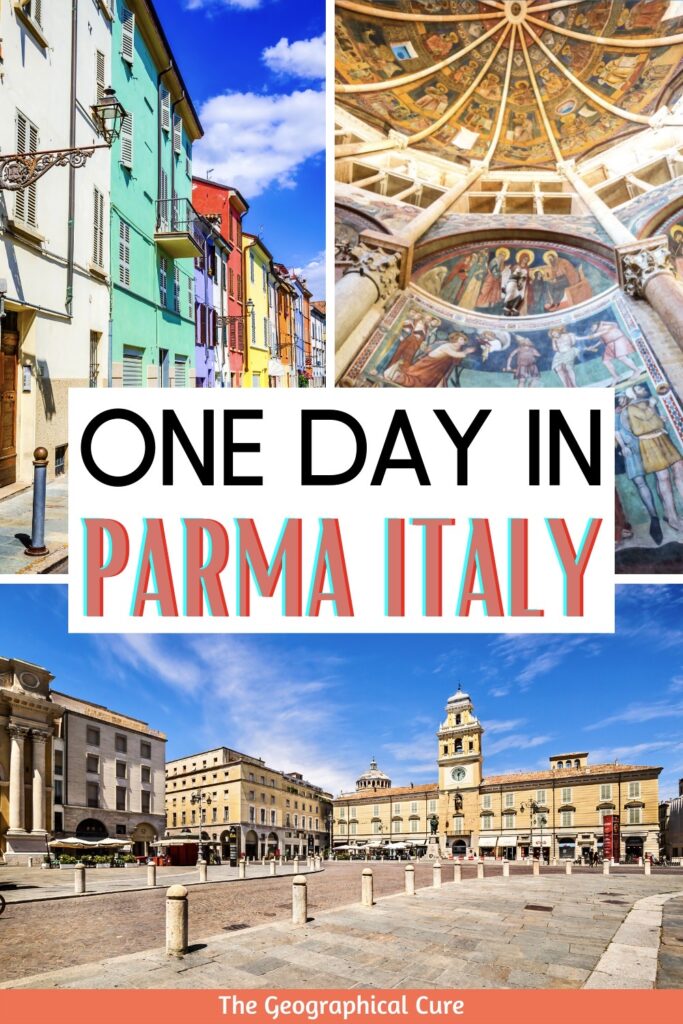
Photos of exceptional beauty and an intriguing article.The enchantment and allure beckon you to discover its hidden treasures. Thank you for the narrative 🙂